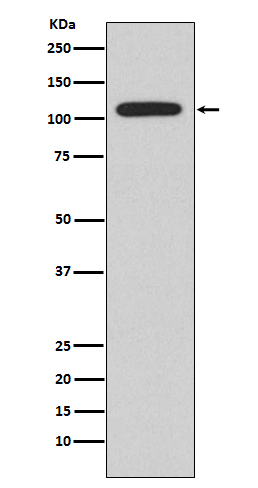产品名称
NFAT2 (16M2) Rabbit Monoclonal Antibody
别名
cytoplasmic 1; NF ATc; NF ATc1; NF-ATc; NF-ATc1; NFAC1; NFAT 2; NFAT2; NFATC 1; NFATc; NFATc1;
纯度
Affinity-chromatography
存储缓冲液
Supplied in 50mM Tris-Glycine(pH 7.4), 0.15M NaCl, 40%Glycerol, 0.01% New type preservative N and 0.05% BSA.
Human Swissprot No.
O95644
免疫原
A synthetic phosphopeptide corresponding to residues surrounding Ser237 of human NFAT2
注意事项
NFAT2 Antibody is for research use only and not for use in diagnostic or therapeutic procedures.
组织表达
Expressed in thymus, peripheral leukocytes as T- cells and spleen. Isoforms A are preferentially expressed in effector T-cells (thymus and peripheral leukocytes) whereas isoforms B and isoforms C are preferentially expressed in naive T-cells (spleen) Isoforms B are expressed in naive T-cells after first antigen exposure and isoforms A are expressed in effector T-cells after second antigen exposure. Isoforms IA are widely expressed but not detected in liver nor pancreas, neural expression is strongest in corpus callosum Isoforms IB are expressed mostly in muscle, cerebellum, placenta and thymus, neural expression in fetal and adult brain, strongest in corpus callosum.
细胞定位
Cytoplasm. Nucleus. Note=Cytoplasmic for the phosphorylated form and nuclear after activation that is controlled by calcineurin- mediated dephosphorylation. Rapid nuclear exit of NFATC is thought to be one mechanism by which cells distinguish between sustained and transient calcium signals. The subcellular localization of NFATC plays a key role in the regulation of gene transcription (PubMed:16511445) Nuclear translocation of NFATC1 is enhanced in the presence of TNFSF11 Nuclear translocation is decreased in the presence of FBN1 which can bind and sequester TNFSF11 (By similarity) {ECO:0000250|UniProtKB:O88942, ECO:0000269|PubMed:16511445}
功能
Plays a role in the inducible expression of cytokine genes in T-cells, especially in the induction of the IL-2 or IL-4 gene transcription. Also controls gene expression in embryonic cardiac cells. Could regulate not only the activation and proliferation but also the differentiation and programmed death of T-lymphocytes as well as lymphoid and non-lymphoid cells (PubMed:
10358178). Required for osteoclastogenesis and regulates many genes important for osteoclast differentiation and function (By similarity).

